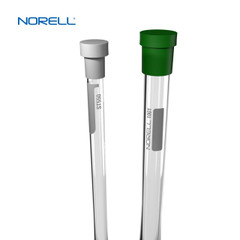|
|
 |
|
 |
NMR Tubes |
|
|
|
 |
 |
 |
 |
Sample Vault™ Series / For Bruker Sample Jet System |
 |
 |
Introducing our new Sample Vault™ Series NMR tubes with NorLoc™ caps, engineered for a new generation of high-throughput lab automation systems. Designed to be used with 96 position carriers using 103.5mm (4") long NMR tubes with open port caps, or 178mm (7") long NMR tubes with closed port caps. NorLoc™ caps have superior sealing capabilities which eliminate cap/tube failure in your instrument. Our patent pending design incorporates a white or blue band positioned on the NMR tubes that aligns with the base of the cap, indicating a properly locked position. Our NorLoc™ cap and Sample Vault™ tube is an integrated closure system for fail-safe delivery of your sample into the magnet. We offer Sample Vault Series™ tubes in both 3mm & 5mm for use up to 700 MHz and up to 950 MHz. Our proven quality and innovative engineering speaks for itself. |
|
 |
 |
|
 |
 |
 |
Standard Series™ for Routine NMR |
 |
 |
Specifically designed for routine NMR, our Standard Series™ NMR tubes are manufactured out of ASTM Type 1 Class B glass, commonly referred to as N-51A. Applications that are suited for using this type of glass are routine NMR where samples are run under room temperatures with no thermal gradients. It is therefore not recommended to fuse this glass with standard vacuum manifolds and the like, since these are generally made out of Type 1 Class A glass.
Each NMR tube is checked for concentricity and camber specifications utilizing the latest computer technology. At Norell we have taken NMR tube manufacturing to a new level of science. |
|
 |
 |
|
 |
 |
 |
Select Series™ for High-Resolution NMR |
 |
 |
Specifically designed for high-resolution NMR, our Select Series™ NMR tubes are manufactured out of ASTM Type 1 Class A glass, commonly referred to as Pyrex® 7740 (Corning), Duran® (Schott Glass), or Kimax® KG-33 (Kimble) glass. Key properties that make this glass type desirable for NMR are its high degree of thermal shock resistance and low expansion coefficient. This allows for a greater margin of safety from breakage when used in variable temperature applications and freeze/thaw cycling, or under any other application where large temperature variations are required in the experiment. |
|
 |
 |
|
|
|
|
|